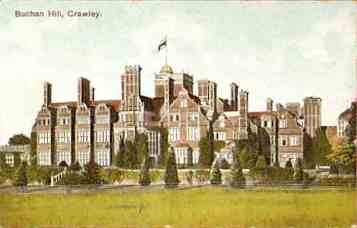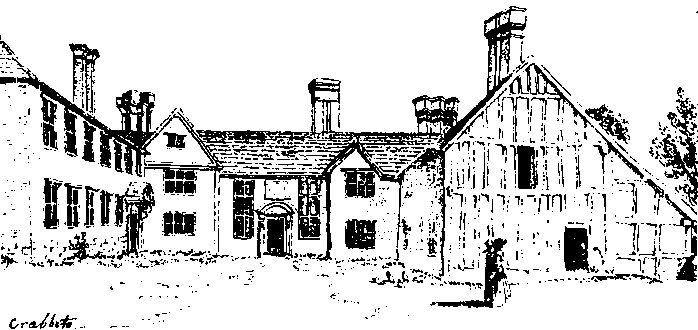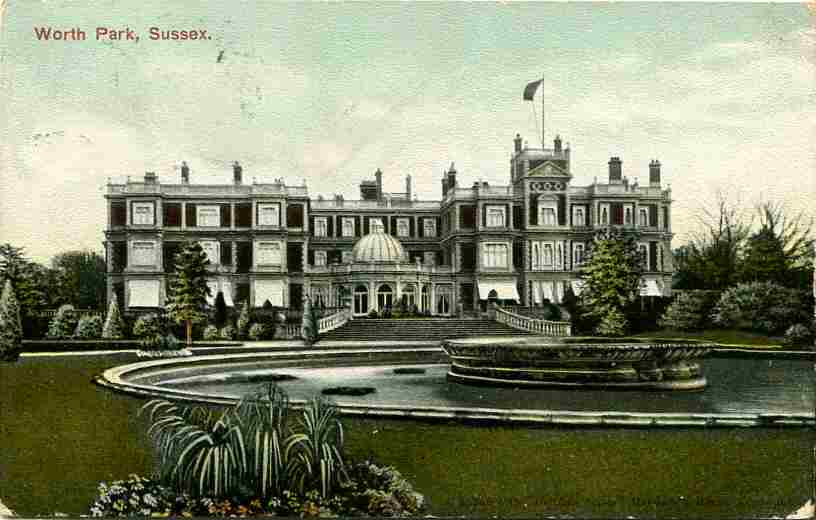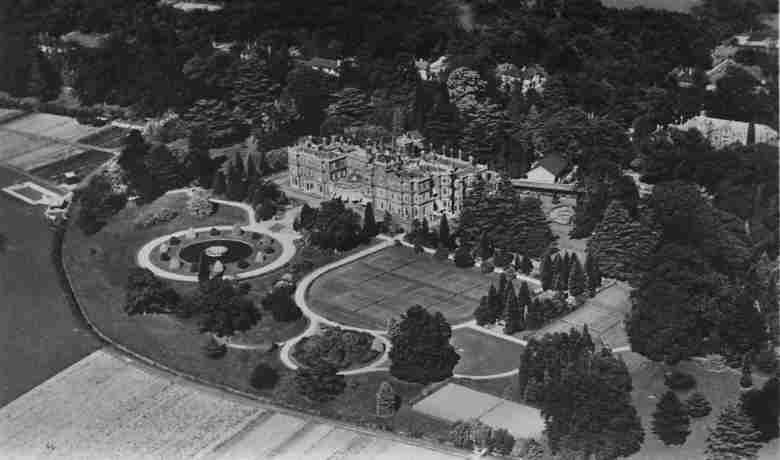
Estates
Bewbush
Beaubush, to the north of St. Leonard's Forest, dates back to the middle ages. It was granted by Henry VII to Lord
de la Warr in 1486, passing on to Lord Berkeley and then Sir Thomas Seymour, who had his lands confiscated by the
crown. The present Bewbush manor house probably had its origins in Tudor times, with Georgian and Victorian additions.
The estate was broken up, and mansions at Holmbush and Buchan Hill were built on the former estate. During the 1970's
the house was converted into flats by Crawley Borough Council.
Buchan Hill

Buchan Hill was once part of Bewbush Park. At the turn of the nineteenth-century it was owned by Lord Erskine,
whose family name was Buchan. The estate was bought by Phillip Saillard,
a London businessman, who built the present mansion in 1882.
Crabbet Park

The earliest reference to Crabbet, which means the “land where the crab apple trees grow”, was in 1296, when it
was the home of John de Crabbewyke. In 1698 the estate was bought by
Leonard Gale , and in 1750 it passed to Samuel Blunt who was married to Sarah
Gale, Leonard's daughter and heir. Crabbet Park House was built in 1873, replacing the original Tudor house,
by Wilfred Scawen Blunt. In 1878 Wilfred and his Wife, Lady Anne, co-founded the
Crabbet Arabian Stud. From 1904 it was the home of Wilfred's daughter, Judith Blunt-Lytton
(later Lady Wentworth), her husband Neville and their three children Anthony, Anne and Winifred. In 1907 Wilfred Blunt
passed his estate to Judith fifteen years before his death, and in 1909 she built a real tennis court, later adding a squash court
and swimming pool. In 1916 she sold most of it, leaving only the house and some adjacent land. The house was converted into flats
about 1960, tenanted until about 1980, then by 1985 it was restored and converted into offices, a software company moving in later
that year. In 1988 the tennis court, squash court and swimming pool were also restored and converted into offices, and is now
known as The Orangery.
Crabbet Park Restored, Crawley Museum Society Newsletter No. 6, Summer 1990
Paddockhurst
Paddockhurst is on the Balcombe to Turners Hill Road. It was rebuilt between 1869 and 1872 for the estate's new
owner, George Smith, by the architect Salvin. Robert Whitehead, pioneer of the modern torpedo, and the engineer Lord
Cowdray occupied the estate during the 20th century before Worth Abbey and School took over.
Tilgate
The Tilgate Estate was bought by John Nix about 1863, who rebuilt the mansion.
The estate covered over 2000 acres, occupying most of the land between the Brighton Road and the London to Brighton
Railway. Tilgate Lodge, in Three Bridges High Street (now Three Bridges Road), was the main entrance to Tilgate
Estate. The Estate was sold in 1939. During the war Canadian troops had a camp in the grounds. In 1959 Crawley Urban
District Council bought the house and park; the park was opened to the public but the house was demolished.
Worth Park
 Worth Park
Worth Park
Originally part of a larger medieval deer park within Worth Forest, the Worth Park Estate covered much of what are now Pound Hill
and the Industrial Estate. The estate was bought by Joseph Meyer Montefiore, a London banker, in the 1840s, who built the mansion in about
1860 replacing a house which burnt down in 1847. Joseph was succeeded by his son, Francis,
who remodelled the house and garden between 1884-1887. The gardens, constructed by James Pulham & Son, were laid out on four levels. The
first level to the east of the main house was a formal garden consisting of three circular areas - The Sundial, Dutch and Fountain
gardens with a semicircular Arts and Crafts inspired walkway to one side. The second level consists of formal terraces separated form the
first by a staircase and balustrading, and a large circular fountain. A ha-ha divides the second from the third level of open parkland,
which leads to a large lake.
 Milton Mount College from the Air
Milton Mount College from the Air
Most of the Estate was sold in 1915, and the mansion was bought by a school originally situated near Milton, Gravesend, opening
it as a girl's school - Milton Mount College - from October 1920. The building was requisitioned
by the War office in June 1940 and the school moved to Lynton, returning in May 1946. The school moved out in 1960 and the house and
gardens were purchased by Crawley Borough Council in 1963. In 1967 the Minister of Housing and Local Government authorised a £2½
million Milton Mount Housing Development Scheme. The mansion was demolished and flats built on the site, but part of the gardens were
retained. The Pulhmite rockery, the fountain and pond basin, Pulhamite rock islet in the lake and Milton Mount Stables are Grade II
Listed (2008).